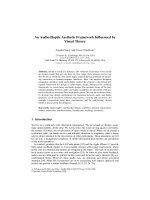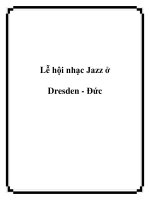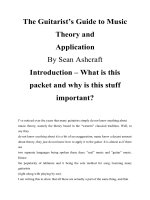Piano jazz improvisation harmony theory
Bạn đang xem bản rút gọn của tài liệu. Xem và tải ngay bản đầy đủ của tài liệu tại đây (2.46 MB, 78 trang )
1
(Piano) Improvisation
Technique
by Musilosophy
www.musilosophy.com
Improvisation means real time composing
Copyright © 2006 Paolo Parrella.All rights reserved.
2
“I know of knowing nothing” ( Socrates )
Music is based on harmony
Harmony is based on chords and scales
Melody and improvisation are based on chords and scales
Accompaniment is based on chords and scales
Chords are based on scales
Scales are based on physics,mathematical principles and musical
tradictions
Musical tradictions are based on human
perception,technology,economy,history,religion…
Copyright © 2006 Paolo Parrella.All rights reserved.
3
SUMMARY
1. Keys
Key awareness
Major
Minor
Scale harmonization
2.Chords
Major 7
th
Minor 7
th
Dominant 7
th
Half diminished 7
th
Diminished 7
th
Inversions
Chord degrees
3.Other scales
Blues
Whole tone
Diminished
Diminished/whole tone
Pentatonic
Copyright © 2006 Paolo Parrella.All rights reserved.
4
4.Melody
Melody building
Chordal notes
Turning note
Passing note
Leaning note
Delaying note
Anticipated note
Chromatic note
Double leaning note
Mixed note
“Wrong” notes
5.Phrasing
Beginning of phrase
Ending of phrase
Imitation
6.Rhythm
Emphasizing offbeats and upbeats
Syncopation
Swing
Polyrhythmics
7.Practice… Practice… Practice…
Generale practice
Progressive drills
Fondamental drills
Greatest piano improvise
Copyright © 2006 Paolo Parrella.All rights reserved.
5
KEY AWARENESS
Scale is a sequence of tones.
It is a base to make music.
The main scales of western music are major and minor scales.
Every scale determines a key,that is an harmonic combunation of tones
based on that scale.
So, F Major key uses the tones of F Major scale.E minor key uses the tones
of E minor scale(s).
I consider the Blues like a key: for example Bb Blues or Bb minor Blues
can be considered two kind of Major and Minor keys
You always have to know in which key you are playing in each moment.
A change of key is called Modulation.
Each scale or key has its own chords.
They are build on each degree of the scale with harmonizations by thirds
You can recognize key by Clef,chords,melody…
Transpose and play in all keys!
The chords of every key are:
Major Key : D Maj Example
Copyright © 2006 Paolo Parrella.All rights reserved.
6
Harmonic Minor Key : D minor example
Natural Minor Key : D minor example
Melodic Minor Key : D minor example
Transpose and play in all keys!
Practice the analysis and recognition of chords, modulations and keys
in
classic music,jazz,pop songs…
Recognize the chords and then the key they belong to.
Copyright © 2006 Paolo Parrella.All rights reserved.
7
! Remember:
Each chord has not an its own scale.
The scale of each chord depends by the key in which it is!
This concept is very important but I have realized that not many musicians have
understood its importance.
For example, they play the D dorian scale also on a Dmin7 that belongs to Bb
key!
Ahi,Ahi… in this way they do two terrible mistakes: E instead of Eb and B instead
of Bb!
Copyright © 2006 Paolo Parrella.All rights reserved.
8
When you improvise on this song you have to use basically the C minor scale
(when you are in C minor key) and Eb scale when you are in Eb key.
This is the key concept.But a melody and so an improvisation is based above all
on chord besides on key.
Copyright © 2006 Paolo Parrella.All rights reserved.
9
Copyright © 2006 Paolo Parrella.All rights reserved.
10
Copyright © 2006 Paolo Parrella.All rights reserved.
11
Copyright © 2006 Paolo Parrella.All rights reserved.
12
Copyright © 2006 Paolo Parrella.All rights reserved.
13
Copyright © 2006 Paolo Parrella.All rights reserved.
14
Copyright © 2006 Paolo Parrella.All rights reserved.
15
Copyright © 2006 Paolo Parrella.All rights reserved.
16
Copyright © 2006 Paolo Parrella.All rights reserved.
17
Chord families
Every melody and accompaniment is based on a chord.
Melody generally uses the notes of a chord or notes that return to it.
In order to improvise you need to know and play every chord very well.
The fondamental drill is playing every chord and every inversion of each
chord.
I suggest to study five families of chords:
1. Major 7
th
chord
2. Dominant 7
th
3. Minor 7
th
4. Half-diminished
5. Diminished 7
th
Play every chord :12 chords X 5 families = 60 chords X 4 inversions =
240 chords
For example:
1. Major 7
th
chord : F Maj 7
• Maj 3
th
+ perfect 5
th
+ maj 7
th
Copyright © 2006 Paolo Parrella.All rights reserved.
18
2. Dominant 7
th
chord : Bb 7
• Maj 3
th
+ perfect 5
th
+ minor 7
th
3. Minor 7
th
chord : Em7
• Minor 3
th
+ perfect 5
th
+ minor 7
th
4. Minor 7
th
dim 5 (half-diminished) chord : Dm7b5
• Minor 3
th
+ diminished 5
th
+ minor 7
th
5. Diminished 7
th
chord : C# dim7
• Minor 3
th
+ diminished 5
th
+ diminished 7
th
Copyright © 2006 Paolo Parrella.All rights reserved.
19
Major 7
th
chord
This chord is on the :
I and IV (#4)degree of the Major key
III (#5)degree of the harmonic and melodic minor key
III and VI (#4) degree of the natural minor key.
! #4 = This chord has augmented 4
th
#5 = This chord has augmented 5
th
In the next page there are major chords in all keys and in 4 inversions
PLAY them many,many times!
It is very important.
Play these chords in the whole keyboard (More than an octave
)
Play them with both hands
Arpeggiate the chords
Copyright © 2006 Paolo Parrella.All rights reserved.
20
Copyright © 2006 Paolo Parrella.All rights reserved.
21
Copyright © 2006 Paolo Parrella.All rights reserved.
22
Dominant 7
th
chord
This chord is on the :
V and degree of the Major and harmonic/melodic minor (b9 and b6) key
VII degree of the natural minor key
IV (#4) degree of the melodic minor key.
! #4 = This chord has augmented 4
th
b6 = This chord has minor 6
th
b9 = This chord has minor 9
th
In the next page there are dominant 7
th
chords in all keys and in 4 inversions
PLAY them many,many times!
It is very important.
Play these chords in the whole keyboard (More than an octave
)
Play them with both hands
Arpeggiate the chords
Copyright © 2006 Paolo Parrella.All rights reserved.
23
Copyright © 2006 Paolo Parrella.All rights reserved.
24
Copyright © 2006 Paolo Parrella.All rights reserved.
25
Minor 7
th
chord
This chord is on the :
II,III, and VI degree of the Major key
I,IV and V degree of the natural minor key
II degree of the melodic minor key.
IV degree of the harmonic minor key
In the next page there are minor 7
th
chords in all keys and in 4 inversions
PLAY them many,many times!
It is very important.
Play these chords in the whole keyboard (More than an octave
)
Play them with both hands
Arpeggiate the chords
Copyright © 2006 Paolo Parrella.All rights reserved.
![[Học chơi piano] Piano for dummies](https://media.store123doc.com/images/document/13/ce/kh/medium_khp1385871499.jpg)








